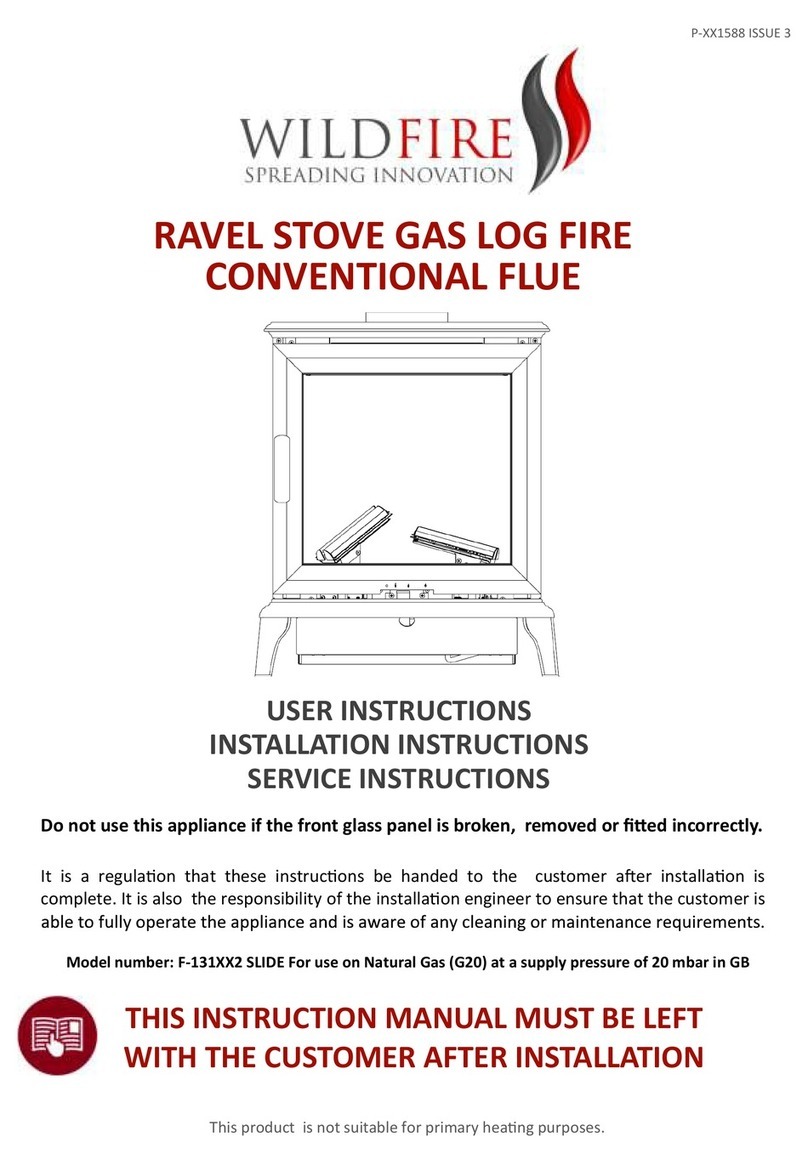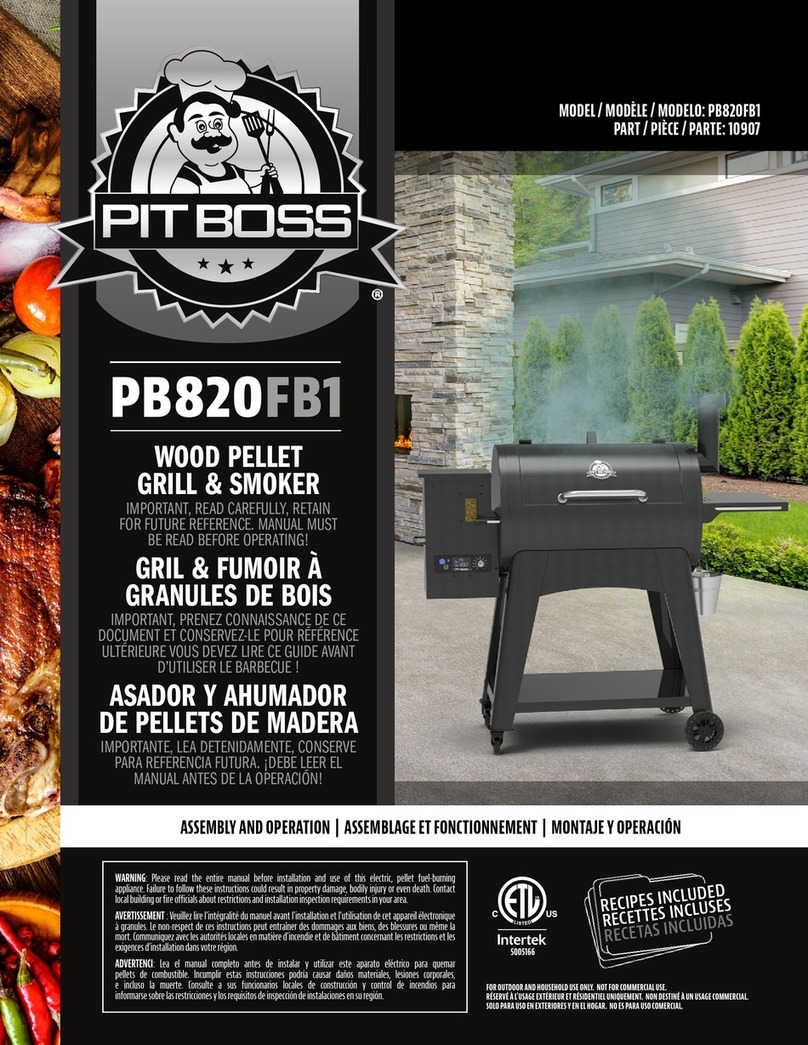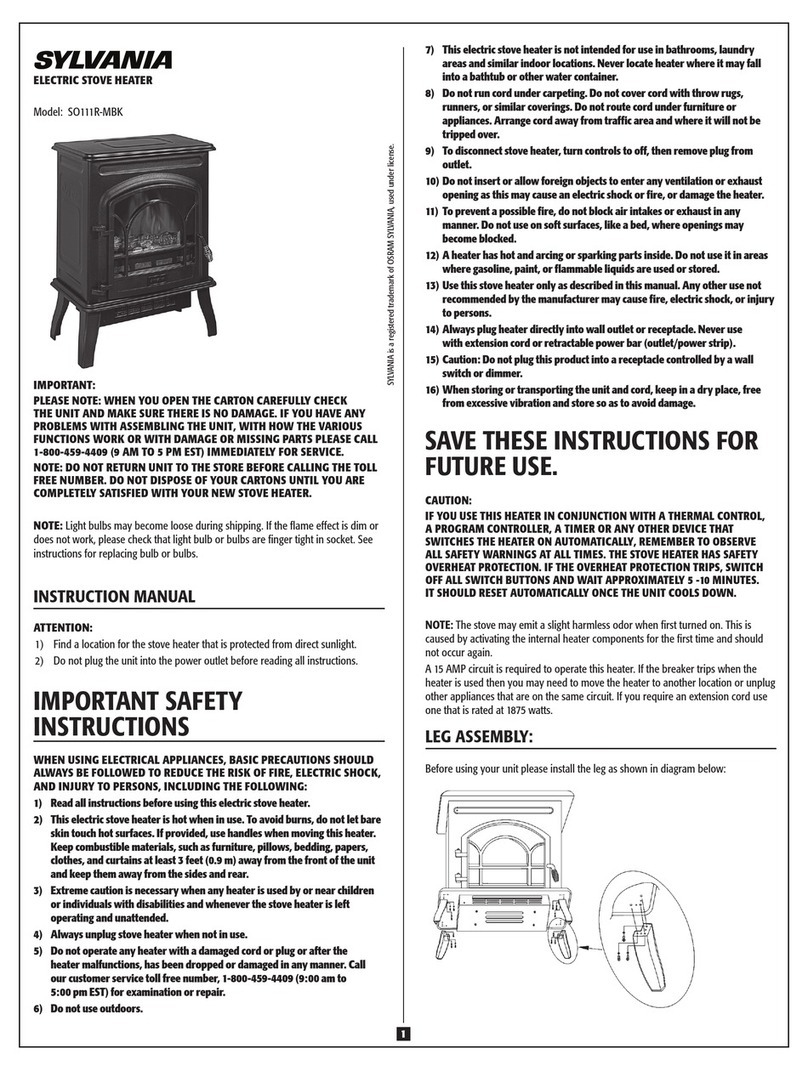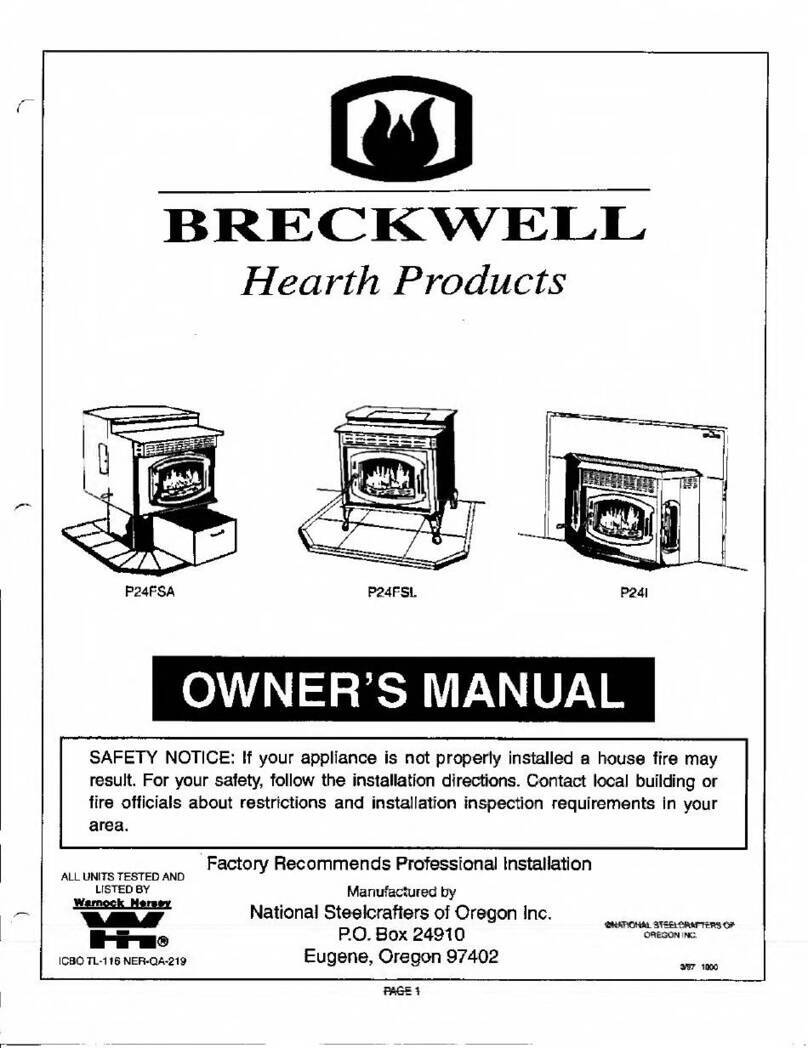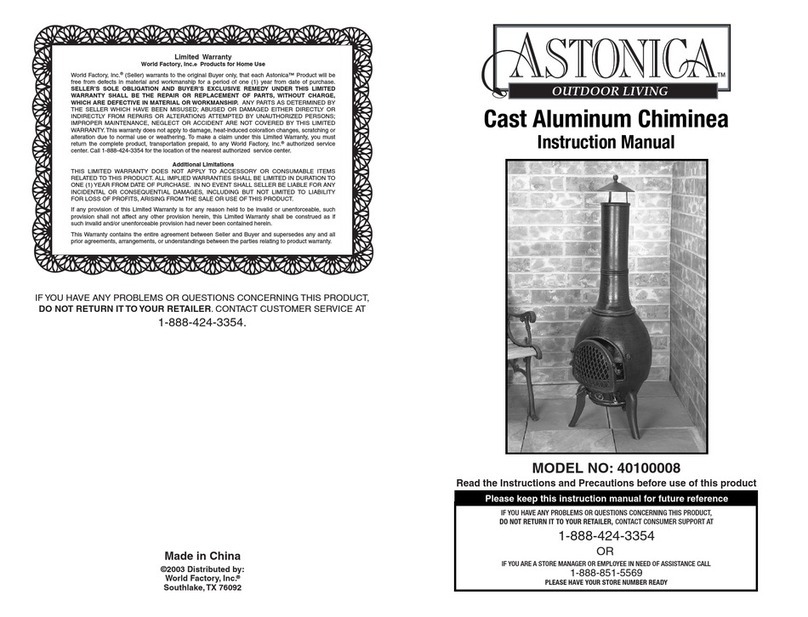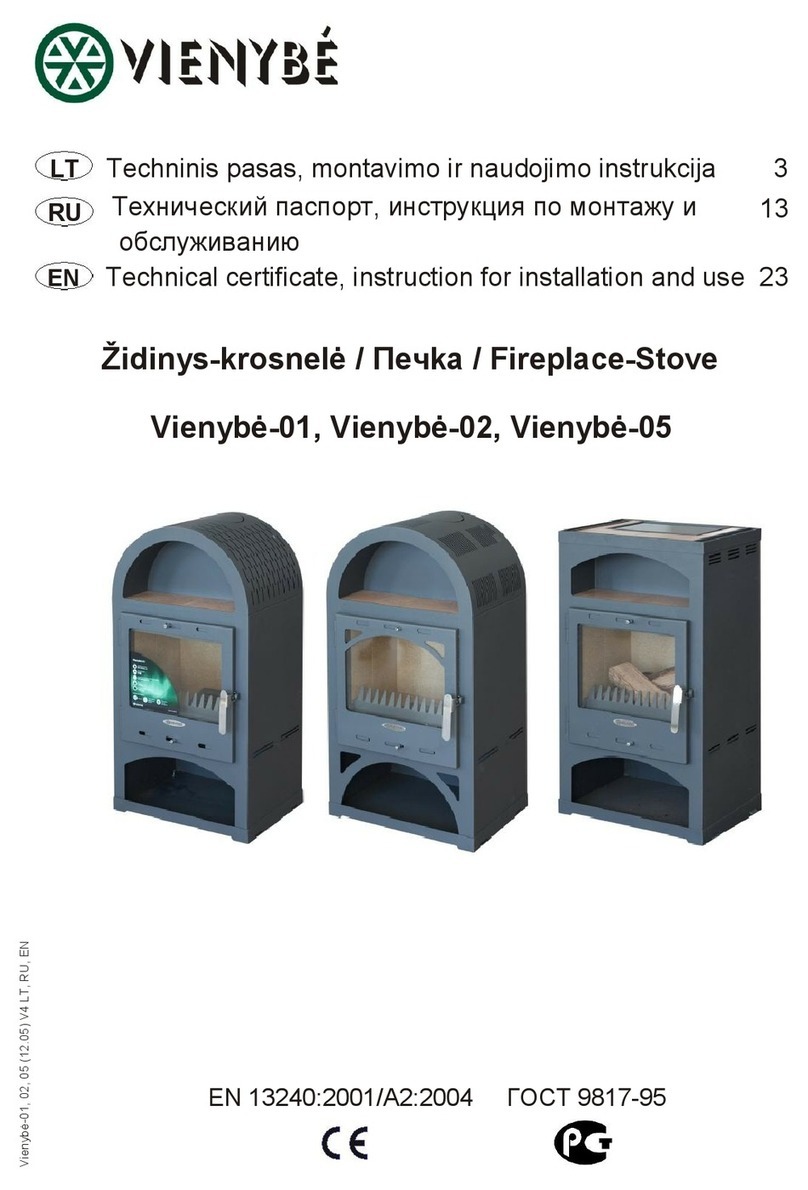
Vienybe EKO ex (17.01) EN
Vienybe EKO ex (17.01) EN
4.2.Requirementsforflueandchimney
Metalpipesusedforconnectionofthefireplacetoachimneymustbemadeofatleast1,5mm
thickness metalsheet.
Achimney,aflue pipeandair-ductsmustcomplywithconstruction regulationsandrules.A
diameterof achimneyholemustbeatleastØ130mm.
Thefireplacemustbeconnectedtoaseparatechimney;nootherdevicescanbeconnectedtoit.
Minimum draught of the chimney at nominal power is 12 Pa. In case the chimney draught istoo
strong, a smoke valve or draught regulator may be installed. It may be installed inside flue or
chimney.Theminimum recommendedheightofthechimneyis5mabovethefireplace.Thetopof
thechimneymustbeabovethehighestpointofaroof.
An opening for chimney cleaning must be provided. It is recommended to clean the chimney
and flue before a heating season and every 3 months afterwards. The flue and chimney must be
inspected foranyblockagesifthefireplacewasnotusedforalongperiodoftime.
It is recommended to install stainless steel liner inside the chimney to protect it from harmful
effects of moisture condensation and smoke exposure.
A flue, connecting the fireplace and the chimney, must be as short as possible and must be
directeduptowardsthechimney.Themaximumrecommendedhorizontallengthoftheflueis1m.
In order to connect a flue to a brick chimney:
-
markaplacewherethefluewillbeconnected;
-
usingsuitabletoolsmakeaholethatisslightlybiggerthanthediameteroftheflue;
-
inserttheflue.Sealthespaceswithfireproofmaterial,e.g.,rockwoolorglasscord.
5.Use
ATTENTION! Maintenance of the fireplace shall be performed only by adults having read this
user's manual. During the use of the fireplace the surface of the fireplace becomes hot; a risk of
burns arises. When opening / closing the door, and adjusting the control valves, it is necessary
to wear protective glove (included in the set). Prior to heating the fireplace make sure there are
noflammableitemsonit.
5.1. Firstheating
During the first heating of the fireplace it can emit a specific smell and visible vapors, and it may
seem that smoke is flowing into a room instead of flowing through the chimney. This should stop
after 1 or 2 full and intensive heating cycles. It is necessary to have a good ventilation of the room
duringthefirstheatingofthefireplace.Lateronthefireplacemaybeheatednormally.
5.2. Heating
Firing up. Fully open an initial air supply valve 5 by shifting it to the left (see Fig. 1.) Fully open a
secondary air supply valve bypulling it towards yourself. Put twoaverage size pieces of firewood
on the bottom of a combustion chamber; leave a gap between those two pieces. Put some
crumpled newspaper or a solid fuel tablet in the gap, then put some shredded and dry firewood
in a crosswise manner and then some average size firewood on top. Light up the paper and
close the door when the paper starts to burn well. A handle of the door may be hot; therefore a
safety glove should be used. Control the intensity of fire with the help of air supplyvalve.
Adding fuel. The first load of fuel must burn completely, i.e., only embers must remain in the
fireplacebeforeadding anewload.Itis necessary toslightlyopenthe doorinordertoevenoutthe
air pressure before the door is opened fully. This will prevent smoke from entering a room,
especially when chimney draught is weak. After adding a new load of fuel it is necessary to close
the fireplace door and fully open primary air supply valve for approximately 5 seconds for the fuel
to start burning well. After this the valves should be closed leaving only a small gap as during the
normal heating. In order to prevent fireplace from overheating it is recommended to use 2,5 kg of
firewood foroneloadatmost.Itisrecommendedtoputthefirewoodparalleltotheglass.
ATTENTION! When adding firewood into the fireplace make sure it does not touch the glass.
Heating during adverse weather conditions. In certain cases, e.g., when ambient
temperature is above 15°C, the weather is rainy and damp, or when a wind is gusty etc., the
chimney draught might be worse than usual. In such cases a minimum amount of fuel should be
usedinthefireplace, andtheinitialairsupplyvalveshouldbefullyopened.
5.3.Ashcleaning
After the fuel has burnt, ashes should be removed from the combustion chamber into an ashbin
using a suitable rake. Ashes should be removed only after they have cooled completely. Ashes
should be poured into a fire-resistant container. Ashes must be removed after every heating;
otherwisetheycanblocktheairsupply.
5.4.Fuel
ATTENTION! Only the recommended type of fuel shall be used for heating; use of other type of
fuel (e.g. coal) may result in overheating of the fireplace. In such case the warranty would not be
applied.
Thefireplaceis designedforusewithfirewood(deciduoustreesrecommended).Firewoodshould
be cut and split. Humidity of firewood used for heating should not be higher than 20%. Such
firewood humidity level is achieved after 1 to 2 year storage of the firewood in a ventilatedshelter.
Use of damp firewood results in reduced power of a fireplace, increased consumption of fuel;
accumulation of resins, cracking of vermiculite plates and faster corrosion of combustion
chamber.Duetohigheraccumulationofresinsuseofconiferousfirewoodisnotrecommended.

